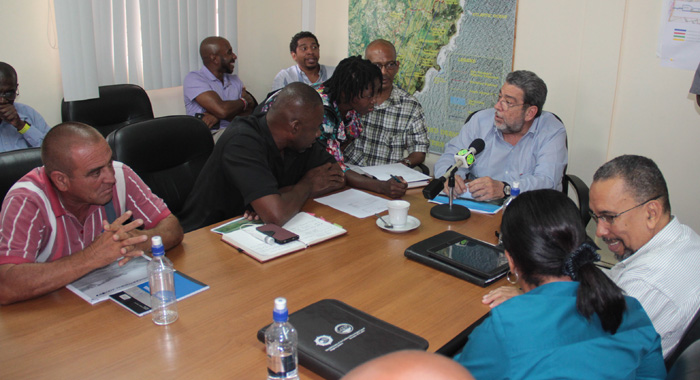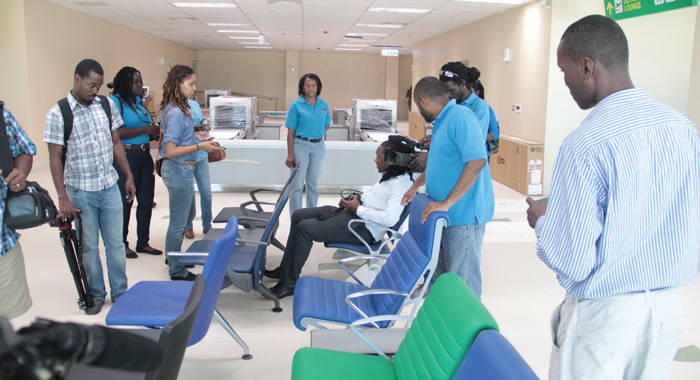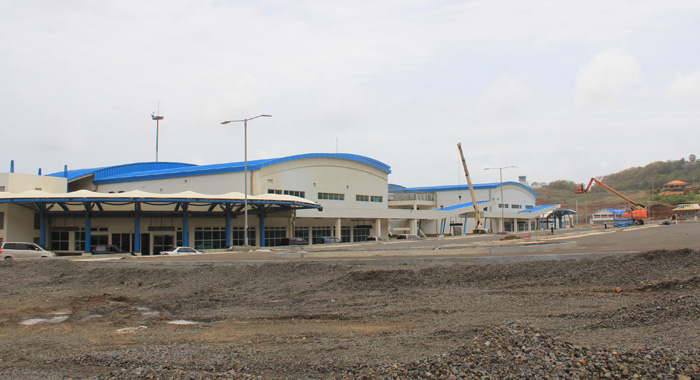The long-delayed Argyle International Airport will be completed by June 2016, the latest in a string of completion targets dating back to 2011.
Rudy Matthias, head of the International Airport Development Company (IADC), the state-owned company responsible for building the airport, told the media on Friday that not even rain should prevent his company from meeting its latest target.
“We cannot foresee every problem we are going to have in the future. But, given where we are today, I believe very strongly that within the first half of this year we should be able to complete all the construction works and have the airport in a state of readiness for operation,” Matthias said.
“Indeed, while we are finishing off the pavement works and the small areas of earthworks that remain to be done, most of our efforts now are focused on putting the management systems in place to have the airport operational,” he said.
Matthias was speaking at a press conference hosted by Prime Minister Ralph Gonsalves after a meeting at the site of the EC$729 million airport.
The meeting brought together various stakeholders, including tourism, national security, finance, and civil aviation officials.
Gonsalves said the presence of Director of Eastern Caribbean Civil Aviation Authority, Donald McPhail at the meeting was important given that his government is “on the verge of completing the airport”.
During the meeting, professionals from Cuba and St. Vincent and the Grenadines addressed the issue of the lighting of the airport.
The talks also including discussions on the outstanding earthworks, concrete pavement, drainage works, production and pavement of asphalt and completion of the perimeter fencing, the prime minister said.
“Those are the practical matters to be done, and, from all the reports which we have received, everything being equal, before the end of June, we should be finished with all of the earthworks and the works in the terminal building,” Gonsalves told reporters.

He said the retrofitting of the terminal building — which was completed three years ago — will be finished before June.
However, two private hangars to be constructed at the airport will not be finished by midyear.
One is being built by Mustique Airways, which should have started in January.
“I believe they are starting on Monday. We are hoping that that hangar will finish in time,” Gonsalves said, adding that he has spoken to the company about the urgency of them commencing.
“Because, clearly, we want when we are opened here, we don’t have a situation where the planes which coming inter-island, between ourselves and the Grenadines, they have to keep E.T. Joshua open for a few — for a short period of time while they complete their hangars.
“And we have been at that, but I certainly spoke to the Mustique Company about the urgency, and head of the Mustique Company, Mr. Jonathan Palmer, he knows of the urgency,” Gonsalves told reporters.
The IADC has hired a Jamaican and a Barbadian to manage the ground handling company and the airport operations.
And Gonsalves said he will meet on Sunday with an American who has been hired on contract to manage the airport.
Vincentians will understand these personnel, said Gonsalves, who noted that a committee set up by Cabinet and not by the political directorate did the hiring.
“As you would appreciate, airport management, ground handling for an international airport, they are all highly-skilled activities. And we have had some people who have done training but you may do training, you get your university degree, but you have to get the experience to be able to operate a modern international airport,” Gonsalves said.
He also had a few words for critics of the airport.
“We are at the stage where the naysayers would see that something which was just a dream is within touching distance to become a reality and we are taking all the steps to put it in a functional manner.”
Meanwhile, Matthias told reporters that the IADC is now focused on operationalization of the airport.
“… as you must have seen when you came by the airport site, the construction works, I don’t want to use the words substantially complete, but it is.
“So, within the next two months or so, we are going to be demobilizing and cleaning up and getting the Argyle International Airport ready for operations. That is what we are working towards and I invite you to come back sometime midyear and see for yourself.

Runway 25 per cent incomplete
But three months before the airport is expected to be completed, some 700 metres (25 per cent) of the 2,700-metre (8,858-foot) runway remain unfinished.
Matthias said workers are laying the base on the 700 metres span, which lies between the two drainage structures — the river and the main drainage structure that takes the water from the apron.
The runway has two layers of asphalt, one eight centimetres thick and the other five centimetres.
“The other areas of the runway already have the two courses of asphalt applied, except for this area 700-metre we are working on now,” Matthias said.
The taxiways in most areas already have the first layers. This should be completed by the end of May.

Minimal weather impact
The IADC has said in the past that the pace of the work had been affected by rain.
But regional forecasters have said that the first half of 2016 will be characterised by lower than average rainfall, with the reverse during the second half.
“We have been affected by the weather to a small extent. We have been affected by equipment breakdown, we have been affected by so many other thing. A big project like this, you will have all sorts of adverse impacts,” Matthias said.
“But, the report that we got this morning suggests to me that we should be able to complete the works by mid-May or thereabout, or, certainly, by the end of May. And that takes into account the likelihood of rain.”







I guess AIA will show up one day doing the things that an international airport does but, in the meantime, there surely is no shortage of supervised public squirming, waffling and doublespeak. I also guess it’s all worth it.
Jeannine, “the things that an international airport does,” if it aims to be successful, is to send and receive passengers to and from international destinations at levels that make the building, operation, and maintenance of the airport minimally viable. This means that the various direct and indirect spin-off effects, in our case the generation of taxable profits in the tourist and allied sectors, will at least match and hopefully exceed the price of the airport, in our case the costs of acquiring the land at and around the airport, the costs of building the airport (including the debts and their servicing), and the costs of operating and servicing the airport, at say 10 years down the road when everything is finally in place and when everyone can accept that the benefits of the airport can surely be seen an assessed.
It would have been possible to at least crudely estimate both the various airport costs and extra-airport revenues as part of a financial feasibility study before any work was started.
Such a study was never done simply because it would have shown that the spin-off revenues would have been far, far below the various costs. Perhaps we would have needed an additional 200,000 annual mainland tourists staying for two weeks to finally begin to break even 10 years down the road when all the new hotels and all the airline visits were fully in place.
Maybe this figure is 100,000 visitors staying for one week. None of the authorities who should have known this figure — even as a plus or minus 25 percent estimate — were interested in knowing it because they fully comprehended that most Vincentians wanted such an airport, the costs be damned, a sentiment they used to their political and other advantage.
It will not at all be worth it, as you claim as our “costs be damned” mentality end up damning us all.
The IADC has proven that they do not know what they are doing. With all the false completion dates they are an embarrassment to the ULP and the country. We all have to hope that enough of the sub-agencies involved in the construction are competent enough to be able to make the airport work, in spite of the very poor planning, conception and runway direction being wrong and the lack of airlines wanting to come here.
“A state of readiness for operation” is not the same as being fully and successfully operational, meaning sending and receiving planes to and from overseas destinations in such numbers that there will be at least a zero net economic gain. In other words, the costs of building, financing, and maintaining the airport should at least be matched by the direct and indirect benefits of the monies spent by the in-transit and stop-over visitors to our country, especially in the tourist sector, in order to call the airport successful, something I believe will never happen.
This airport, operational or not, will sink us in a sea of debt and lost opportunities.
Which international airlines are committed to fly to Argyle? None, you say? I thought so. It even looks like Mustique Airways is very unhappy to go to Argyle since most of their flyers are already well serviced by Grantley Adams airport in Barbados. Since almost the only passengers from Arnos Vale to Mustique are mainland workers, this will be a very expensive move for them. The same holds true for SVGAir.
But we are at the point of no return and only the mercy of God can save us from the awful fate that is upon us.
Something I and others have generally ignored in discussions of the airport and its tourist-generating implications are the issue of legal and illegal concessions.
First, generous concessions will have to be given to any international airlines willing to land at Argyle. At the extreme this would involve waiving all landing and other fees that airlines generally have to pay for the privilege of using and airport and its facilities together with an agreement to pay for all empty seats.
No government-owned airport would be willing or able to accept these terms unless those landing would be wealthy people who spent so much on their visit — say by gambling at government-owned casinos — that these terms would be more than worth it. In any event, the concessions granted would be an additional cost, perhaps the highest cost, of running the airport itself.
Second, any new foreign hotels and resorts (locals would hardly have the tens of millions to build such facilities) would be granted long-term land leases at peppercorn rates and would be given duty-free import and income-tax exemptions lasting up to 20 years. Again, this would adversely impact the value-added rationale of the whole enterprise. in our case, it would make it far more difficult to pay for the airport and its operation and upkeep.
So why do governments, especially poor underdeveloped or developing countries, accede to such quasi-extortionary concessions? Three reasons: jobs-jobs-jobs.
High unemployment is a huge problem in such countries. Helping create new jobs is also a good way to win loyal voters.
There is also the less obvious but equally common motive of concessions going both ways. In the Caribbean alone, there are many ways for elected and unelected government functionaries, high and low, to readily benefit financially from negotiating contracts with outside tourism developers. This is illegal, of course, but the greed of too many politicians and their bureaucrats has no limits.
At the end of the day, it is easy to see why governments in poor countries like our own are so eager to climb on the tourism bandwagon regardless of whether their people and country actually benefit in the process.